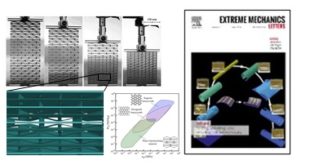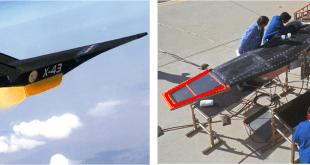Manufacturing technology breakthroughs in recent years, such as 3D printing, have allowed precise material placement, new material behaviors, and complex shaping of parts and structures. Design tools, however, have not kept up with the complexity of the design space resulting from these advances.
DARPA’s TRAnsformative DESign (TRADES) program, which began in 2017, set out to develop foundational design tools needed to explore the vast space opened by new materials and additive manufacturing processes commonly called 3D printing. The program recently concluded having successfully developed new mathematics and computational techniques, including artificial intelligence and machine learning, that will allow future designers to create previously unimaginable shapes and structures of interest to defense and commercial manufacturing.
TRADES, which stands for TRAnsformative DESign, is a program within the DOD Defense Advanced Research Projects Agency (DARPA). The essence of the program is to synthesize components of complex mechanical platforms (e.g., ground vehicles, ships, or air and spacecraft), which leverage advanced materials and manufacturing methods such as direct digital manufacturing. To balance the freedom of shaping with material distribution requires rethinking the relationship between computers and users as the number of design possibilities exceeds human capacity and current state-of-the-art systems. One of the major thrusts in this program is to understand how massive amounts of computing power could fundamentally change the way we approach design problems and associated computational tasks.
TRADES Program
The program is a 48-month effort addressing two Technical Areas (TAs). In TA1, performer teams will explore and develop new mathematical and computational foundations that can transform the traditional design process. Ten teams from industry, academia, and government are evaluating competing approaches in TA1. TRADES leadership will evaluate these approaches against a set of challenge projects that will be released over the life of the effort.
TA2 is for the provision of a software integration platform for TA1, creating a common resource for collaboration and sharing of prototype implementations; this technical area is awarded to TACC.
TRADES Awards
In 2018, The Texas Advanced Computing Center (TACC) at The University of Texas at Austin announced that it has partnered with the U.S. Department of Defense (DOD) to provide researchers with access to advanced computing resources as part of an effort to develop novel computational approaches for complex manufacturing and design problems.
When DOD deploys a new system in the field, total system costs include not only the cost to produce each article, but also the R&D costs that went into developing it, and the costs of maintaining and operating that system over its functional life. Bringing advanced computation to the manufacturing and design processes allows designers to evaluate new designs from a physics perspective to answer questions like: How do we balance shaping versus material distribution? How can we create infield spares and compensate for dramatic different material properties (e.g., create a polymer component to replace a metal part)? What design spaces open up with advanced materials and additive manufacturing processes? How do we effectively convey these new design options to a designer?
TACC’s approach will be to provide a comprehensive platform that these researchers with varying technical backgrounds can use to easily construct new environments in support of developing computational methods, creating and using data visualizations, and analyzing large or complex experimental data sets. TACC cyberinfrastructure tools and services are built upon open source whenever possible.
The technologies TACC will provide in support of the TRADES program feature: High-performance computing; Rapidly configurable cloud computing; Flexible storage; Diverse user interfaces; and Existing training
“TACC has constructed an unparalleled cyberinfrastructure for engineering and science researchers,” said Dan Stanzione, executive director of TACC. “Applying this with DARPA in advanced manufacturing will show how higher education computing technologies can transform U.S. manufacturing and provide a competitive edge.”
Siemens worked with DARPA
Put simply, DARPA TRADES intends to find revolutionary solutions to designing and manufacturing tomorrow’s ultra-complex products. We have been working with our project partners—Georgia Tech, Michigan State University, and PARC—for three years and have derived some amazing results, said Mark Burhop, Principal Investigator.
One of the first accomplishments was the ability to represent huge amounts of geometry in the design tool. For you CAD designers, go to your system right now and see how many objects (spheres, cylinders, cones, etc.) you can create in your design before it gets too big to be usable. Can you do 100,000? 1,000,000? 10,000,000? We got to 1015 (100,000,000,000,000) with no loss in accuracy.
Why is this important? For some time, additive-manufacturing companies have liked to say that customers get “complexity for free” because their hugely flexible machines can create complex shapes (almost) as easily as simple shapes. Designs that were previously not possible with machining, injection molding, sheet-metal bending and other methods have now become physically possible. However, representing such complexity has been a massive challenge for design software because of the incredible amount of geometry involved. DARPA TRADES recognizes that advancing the state of the art is crucial for future manufacturing that is expected to be far more flexible than we have today.
Addressing this representation problem was just the first step in the research. How do you analyze and optimize such a huge amount of geometry resulting from these new methods? You certainly can’t do a simple finite element mesh. It is just too big. After analyzing the design, how do you optimize it? It won’t be just three or four design variables that you want to change but maybe hundreds or millions.
Despite the marketing around additive manufacturing (AM), any regular user of AM equipment that is printing complex geometry, such as a lattice, knows that the process is hardly “push button.” Design for Additive Manufacturing (DfAM) plays a very important role here. This does not just mean considering things like supports and warping of the AM part in the design. It also means being able to explore the huge design space that is now possible.
For Siemens and our customers, the potential of this project means better products. New designs can be more complex but with more and better performance characteristics and reliability. This project can help expand what designers can do without making their job more complicated. That’s why Corporate Technology got involved in the first place and why we see DARPA TRADES as crucial to the evolution of manufacturing.
TRADES Status
The U.S. Defense Advanced Research Projects Agency (DARPA) in Arlington, Va., concluded the Transformative Design (TRADES) program in 2021, which ran from 2017 to 2020. The project sought to approach additive manufacturing from the software side, to “advance the foundational mathematics and computational tools required to generate and better manage the enormous complexity of design.”
In the past four years, TRADES has explored new ideas from mathematics and computer science that have allowed them to represent things – like parts and components – that are a million times more complex than current state-of-the-art systems can represent. They can now describe both shape and material in a coordinated way across multiple physics to allow intricate designs and to understand properties at every point on the produced part. The aim is to be able to mimic integrated hierarchical structures found in nature, where different sized structures respond to different types of physics.
That manual handling, moving data from design systems to analysis, absorbs 50% of the entire design cycle because the formats are not compatible and current systems can’t directly interoperate. TRADES has developed new concepts that would eliminate that bottleneck and accelerate the design process to include automated synthesis, where a computer explores design alternatives across multiple physics such as thermal, mechanical, electro-optic, and the like, without human intervention. This would turn computers into true collaborative partners to help create new designs that are not intuitive to even the best human designers.
TRADES is also enabling design for dynamic problems where structures change as time evolves, such as a solid-rocket engine, which changes its internal shape as the propellant burns. The TRADES design tools have made significant headway in addressing the time and cost burdens associated with current design cycles for DoD platforms and should enable a rapid and effective response to new and evolving threats and requirements. This includes generating in-field spares where shaping accommodates some of the discrepancies caused by material substitutions.
The advanced design tools, processes, and algorithms developed in the TRADES program are poised to help increase the performance of DoD platforms; reduce the cost and time associated with materials and geometry selection, optimization, and numerical analysis; and enable exploration of new design concepts that are currently out of reach.
 International Defense Security & Technology Your trusted Source for News, Research and Analysis
International Defense Security & Technology Your trusted Source for News, Research and Analysis


